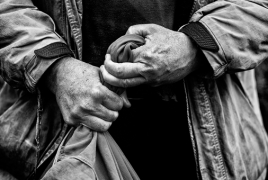Armenia quake in focus of new study on PTSD early treatment benefits February 15, 2020 - 11:51 AMT PanARMENIAN.Net - In 1988, a 6.9 magnitude earthquake struck near the northern Armenian city of Spitak. The temblor destroyed cities and is estimated to have killed between 25,000 and 35,000 people, many of whom were schoolchildren. The latest findings from a long-term, UCLA-led study reveal that children who survived the quake and received psychotherapy soon after have experienced health benefits into adulthood, Medical Xpress says. The findings are particularly relevant today, said Dr. Armen Goenjian, the study's lead author and a researcher at the Jane and Terry Semel Institute for Neuroscience and Human Behavior at UCLA, given the increased frequency and severity of climate-related catastrophes such as hurricanes and wildfires. This ongoing project is one of the first long-term studies to follow survivors of a natural disaster who experienced post-traumatic stress disorder, or PTSD, more than five years after the event. The research tracks PTSD and depression symptoms in people who received psychotherapy as children, as well as those who did not. The latest findings, published in the journal Psychological Medicine, also identified factors that contributed to the risk for PTSD and depression among the Spitak quake survivors, including whether their homes were destroyed, the severity of adversity they faced after the earthquake and whether they had chronic medical illnesses after the quake. People who experienced strong social support were less likely to develop PTSD and depression. The researchers evaluated 164 survivors who were 12 to 14 years old in 1990, about a year and a half year after the earthquake. Of that group, 94 lived in the city of Gyumri, which experienced substantial destruction and thousands of deaths. The other 70 lived in Spitak, where the damage was far more severe and there was a higher rate of death. A few weeks after the initial assessment, mental health workers provided trauma- and grief-focused psychotherapy in some schools in Gyumri, but not in others because of a shortage of trained medical staff. "We were comparing two devastated cities that had different levels of post-earthquake adversities," Goenjian said. "People in Spitak, who experienced more destruction, earthquake-related deaths and injuries but experienced fewer post-earthquake adversities, had a better recovery from PTSD and depression than survivors in Gyumri." Researchers interviewed survivors five and 25 years after the earthquake. They found that people from Gyumri who received psychotherapy had significantly greater improvements in both their depression and PTSD symptoms. On the 80-point PTSD-Reaction Index, for example, PTSD scores for the Gyumri group that received psychotherapy dropped from an average of 44 a year and a half after the earthquake to 31 after 25 years. PTSD scores for people from Gyumri who did not receive treatment declined as well, but not as much: from 43 at one-and-a-half years to 36 after 25 years. The number of state universities will be reduced from 23 to 8 by 2030, Minister of Education, Science, Culture and Sport Zhanna Andreasyan has said. From September 21 to November 11, a total of 2,820 Russians registered at a place of residence in Armenia, the police has said. The situation on the contact line between Karabakh and Azerbaijan was relatively stable overnight, the Defense Army says. Defense Minister Suren Papikyan has visited the southern Armenian province of Syunik, the Defense Ministry reported on March 18. Partner news |